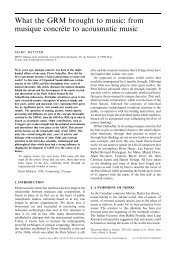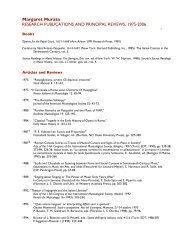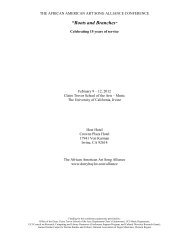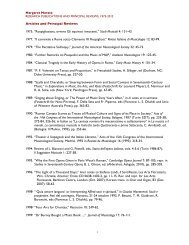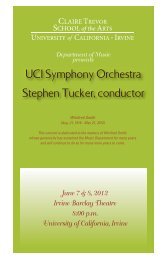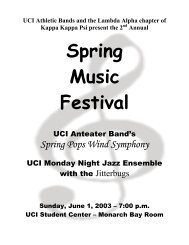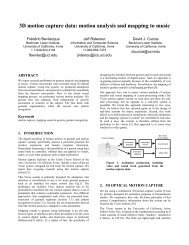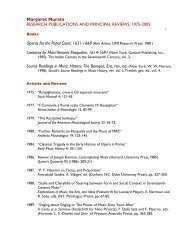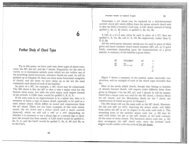amy bauer The Other of the Exotic: Balinese Music as Grammatical ...
amy bauer The Other of the Exotic: Balinese Music as Grammatical ...
amy bauer The Other of the Exotic: Balinese Music as Grammatical ...
Create successful ePaper yourself
Turn your PDF publications into a flip-book with our unique Google optimized e-Paper software.
<strong>The</strong> <strong>O<strong>the</strong>r</strong> <strong>of</strong> <strong>the</strong> <strong>Exotic</strong> 369<br />
27. Indonesian gongs, no matter what size, vibrate at impact from two principal modes<br />
<strong>of</strong> vibration with frequencies in a 2:1 (octave) ratio. Immediately after striking,<br />
however, a gong will develop multiple modes, each <strong>of</strong> which decays at a different<br />
rate; see Rossing (2000), pp. 98–100.<br />
28. Because <strong>the</strong> total number <strong>of</strong> bars – 89 – in ‘Galamb borong’ is a member <strong>of</strong> <strong>the</strong><br />
Fibonacci series, it is perhaps worth pointing out that <strong>the</strong> lowest pitch <strong>of</strong> <strong>the</strong> piano<br />
is reached approximately at <strong>the</strong> golden section (not bar 55, but bar 53) and <strong>the</strong><br />
highest one-third <strong>of</strong> <strong>the</strong> way into <strong>the</strong> piece (bar 30).<br />
29. See Wilson (1992), p. 64.<br />
30. See Lewin (1993).<br />
31. Transpositions are simply identified by <strong>the</strong> scale degrees on which <strong>the</strong>y occur, while<br />
motive inversions are related by index number to <strong>the</strong> first appearance <strong>of</strong> each<br />
component.<br />
32. Pitch-cl<strong>as</strong>s sets [0257], [0358], [0237], [01368] and [025].<br />
33. Speaking <strong>of</strong> <strong>the</strong> Requiem, Ligeti said: ‘I used <strong>the</strong> twelve-note chromatic scale in <strong>the</strong><br />
Kyrie. But what you actually hear is not a chromatic scale, since <strong>the</strong> singers cannot<br />
help making mistakes in <strong>the</strong> intonation, which produces a kind <strong>of</strong> microtonality,<br />
dirty patches; and <strong>the</strong>se “dirty patches” are very important (if <strong>the</strong>y follow <strong>the</strong> score<br />
too loosely that is also wrong, <strong>the</strong> result will be too dirty). Listening to this piece,<br />
what you hear is not <strong>the</strong> twelve-note chromatic scale but all kinds <strong>of</strong> o<strong>the</strong>r intervals’<br />
(Ligeti, Várnai, Häusler and Samuel 1983, p. 53).<br />
34. Salomen, quoted in Swed (2006).<br />
35. In current discourse <strong>the</strong> cosmopolitan carries a wide range <strong>of</strong> connotations, but I<br />
refer here specifically to definitions advanced by Beck (2002), p. 17 and (2003),<br />
pp. 55–7; and by Roudomet<strong>of</strong> (2005), p. 116.<br />
36. <strong>The</strong> spectacle <strong>of</strong> featuring <strong>the</strong> Banda-Linda musicians <strong>of</strong> <strong>the</strong> Central African<br />
Republic on stage alongside a performance <strong>of</strong> Ligeti’s music first occurred at <strong>the</strong><br />
Théâtre du Châtelet in Paris on 20 December 1999; a fur<strong>the</strong>r concert took place<br />
two years later in <strong>the</strong> Kammermusiksaal <strong>of</strong> <strong>the</strong> Philharmonie in Berlin.<br />
37. Scherzinger’s reading recognises several complicating factors unique to this particular<br />
performance and to Ligeti’s ‘African-influenced’ works. It is likely that<br />
ethnomusicological descriptions <strong>of</strong> particular African practices influenced several <strong>of</strong><br />
<strong>the</strong> Ligeti Études ra<strong>the</strong>r than direct exposure to <strong>the</strong> music. None <strong>of</strong> <strong>the</strong> works<br />
featured in <strong>the</strong> recording or concert related directly to <strong>the</strong> music <strong>of</strong> <strong>the</strong> Aka pygmies<br />
(for that matter, works cited elsewhere by Steve Reich are most closely related to<br />
Ghanaian drum ensemble traditions). For his part, Scherzinger is moved to <strong>as</strong>k<br />
(2006, p. 258) whe<strong>the</strong>r <strong>the</strong> mere representation <strong>of</strong> African musicians alongside<br />
Western will ‘encourage <strong>the</strong> complex critical praxis required to allay <strong>the</strong> dr<strong>as</strong>tic<br />
inequality between Africa and Europe’. As it stands, <strong>the</strong> 2003 Teldec disc he cites<br />
w<strong>as</strong> in fact preceded by two similar recordings by <strong>the</strong> Belgian pianist Jan Michiels<br />
in 2001: Banda Linda (Megadisc MDC 7821), which features Book 1 <strong>of</strong> <strong>the</strong> Études<br />
paired with African music, and Gong kebyar (Megadisc MDC 7820), which combines<br />
Book 2 with a sequence <strong>of</strong> <strong>Balinese</strong> music.<br />
<strong>Music</strong> Analysis, 27/ii-iii (2008)<br />
© 2009 <strong>The</strong> Author.<br />
Journal compilation © 2009 Blackwell Publishing Ltd.



